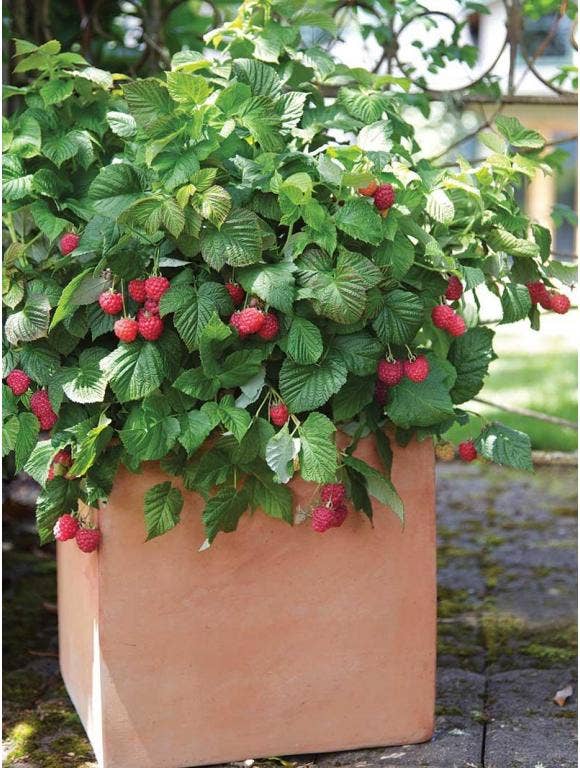
Don't despair if your garden's footprint isn't huge — a small plot or patio is enough space for growing a variety of small fruit plants. A fruit garden may require a little patience as many fruits don't provide the near-instant gratification that most vegetables do. But if you begin with quality bare roots and maintain the right growing conditions, it's possible to cultivate a bounty of small fruit plants season after season.
About Small Fruits
All fruits contain seeds but they grow from different types of plants. Some, such as lemons, figs and apples, grow on trees. Kiwis, grapes and melons are vine plants, and others, like blueberries and raspberries, grow on bushes.
Some plants bear fruit faster than others. In the ground, hanging from baskets, in raised beds and up vertically in tower planters, strawberries will be ready to harvest in about four weeks. Blackberries and raspberries take one to two years to bear fruit after planting. Others, like blueberries and fruit trees, require a longer commitment as they may take three to five years before producing. Dwarf and semi-dwarf fruit trees, perfect for containers, will produce fruit more quickly than standard-sized relatives and are easier to maintain and protect from pests.
Small Space Gardens
A small space fruit garden might include dwarf fruit trees planted in containers, apples coaxed into espaliers on an empty wall or melons crawling up a trellis.
If you garden in a zone that experiences freezing winters, be sure to choose cultivars that can withstand those frigid temperatures. Apples, peaches, plums, blueberries, strawberries and grapes are good cold-hearty choices. Any dwarf tropical fruit trees should be overwintered indoors.
How to Begin a Fruit Garden
You can begin your fruit garden with seeds, plants, bare roots or a combination of the three.
Growing From Seed
Some fruit plants, like melons, do best when directly sown in the garden outdoors. Just make sure to sow seeds after all danger of frost in your area.
Planting Bare Roots
A variety of small fruit plants, including berry bushes, fruit trees, grapes and strawberries, are available in bare root form. They aren't potted in soil but arrive with their roots packed in damp woodchips. Plant dormant bare root plants in early spring to give them an ample growing season before winter. Because bare root plants are generally available earlier in the season than potted plants, you can get a head start planting them in your garden.
Starting With Established Plants
Established plants offer convenience and allow you to buy a bit more time before planting them as they're already prepped and ready to plant.
How to Cultivate a Small Fruit Garden
Soil and Sun
Whether grown in the ground or in containers, small fruit plants don't like "wet feet" where their roots sit in waterlogged soil. They need well-drained, compost-rich, loamy soil. To plant in the ground, dig a hole at least three times the size of the root ball and set the plant in it so that the root ball is level with the surrounding soil line. After placing the plant, backfill the soil, pushing it firmly into the hole, then water deeply to seal any air pockets around the root ball. Don't rely on memory — place a plant marker to identify the type and location of each fruit plant!
Most fruit plants need eight hours of full sun but a few, including raspberries, blackberries and some strawberry varieties, will tolerate partial shade.
Plan for Pollination
When space is at a premium, choose self-pollinating (also known as self-fruiting or self-fertile) varieties that don't need a companion tree or shrub to produce fruit. Figs, strawberries, blackberries and raspberries do not need a pollinator plant companion. If you go with plants that aren't self-pollinating, plant a minimum of two of each kind to ensure pollination. Blueberries produce bigger yields when you plant at least two varieties. Other fruits that need a pollinator include apples, plums, peaches and pears.
Multitask With Mulch
Mulch is one of the gardener's best aids for helping to nurture and safeguard plants. In addition to enhancing soil health, mulching helps to retain moisture and combat weeds that compete for essential water and nutrients. To insulate the roots and keep them warm after planting, mulch the soil around small fruit plants to a depth of 2 to 3 inches.
Feed Small Fruit Plants
Before any leaves begin to sprout, feed your small fruit plants with a granular fertilizer, such as Burpee Organic Tomato + Vegetable Granular Plant Food 3-6-4 or Burpee Organic All Purpose Granular Plant Food 4-4-4. Apply according to the label instructions.
Extend the Harvest Season
To extend the harvest season, plant both early and late small fruit plant varieties. Autumn and early winter are good times to allow small fruit plants to grow uninterrupted. Even as fall temperatures begin to drop, soil temperatures will remain warmer for a while to enable excellent root development.
With the right plant choices and growing conditions, even the smallest fruit garden can deliver a large yield of fresh fruit throughout the year.
Find a wide variety of fruit seeds and plants on the Burpee site to get your garden started.



